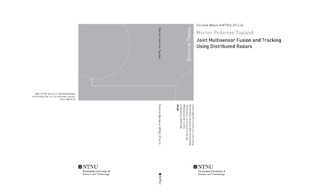| dc.description.abstract | This thesis deals with multisensor fusion in the presence of systematic errors in
the context of target tracking. A typical target tracking problem consists of multiple
sensors producing position measurements of multiple targets, for instance
aircraft. The goal is to establish tracks on all targets that are observed by the sensors.
A track usually consists of an id, such as a track number, target position,
and target velocity. The systematic errors are modeled as measurement biases. If
unaccounted for these biases may lead to inaccurate estimates of the target state
(position and in particular velocity) and a single target may appear as several targets
if the biases are large enough (ghost tracks). Furthermore, if all sensors are
biased it is challenging to find an unbiased estimate of target state with respect
to a coordinate system independent of the sensors.
In this thesis the sensors are radars producing measurements in 3D. The systematic
errors (biases) are called alignment bias, location bias and sensor bias.
The first two are related to sensor deployment, as they describe errors in orientation
(misalignment) and sensor placement (location). The sensor bias addresses
errors caused by sensor imperfections. These biases are estimated relative to a
sensor independent coordinate system and relative to a sensor of reference (master
sensor). A novel distinction is made in this context, where a universal bias
estimator (UBE) is used relative to sensor independent coordinates, while an absolute
bias estimator (ABE) is used relative to a master sensor. The estimability
of the biases is investigated using a novel estimability index, which quantifies
whether a bias can be estimated more accurately with the available measurements.
The estimability index is based on the Cramer-Rao Lower Bound.
The study of estimability is used to determine a multisensor-multitarget scenario
where several bias estimators are compared with respect to performance
using a Monte Carlo simulation. The simulation includes alignment, location
and sensor biases, and all sensors are affected. The estimators are evaluated in
sensor independent coordinates and master sensor coordinates. Two Kalman Filter
(KF) based estimators are used as references. A lower bound is represented
by a KF where the bias values are known, while an upper bound is represented
by a KF where the measurement noise is increased to reflect the biases present.
The alignment, location and sensor biases contain three elements each, to a total
of nine bias values to estimate per sensor. The UBE performs well (below
the upper bound) in sensor independent coordinates when one of the sensor bias
values are removed from the simulation, estimating eight bias values per sensor.
Performance is close to the lower bound when the location bias only is removed,
yielding six bias values per sensor. In master sensor coordinates the ABE has
the best performance. However a simplified version has almost identical performance.
It is called the Relative Bias Estimator (RBE), and it neglects the biases
of the master sensor. This is a popular assumption in the literature, and this study
confirms that this simplification should be preferred in an implementation.
Possible extensions of this work are explored. First curved target motion is explored
by letting the target move at constant altitude above the Earth. The curvature
of the trajectory results in increased bias estimability. However, observing
this curvature requires observing the target for a long time with high accuracy.
This is challenging in practice, and therefore this path was not explored further.
Second, extending the application to Air Traffic Control (ATC) is considered. At
airports radars typically produce 2D measurements, so to extend the developed
3D bias estimators it is necessary to incorporate altitude measurements from the
aircraft Mode C transponders with these 2D measurements. The altitude measurements
are quantized and received with a coarse resolution which may have
a negative impact on bias estimator performance since the vertical velocity estimate
becomes unstable. Several estimators are developed to estimate altitude
and vertical velocity, and these are tested on real measurement data for a performance
comparison. The main contribution is the use of the Interacting Multiple
Model (IMM) and Unscented Kalman Filter (UKF) based estimators on quantized
real world measurements. The UKF produces the best performance for
long term altitude predictions, meaning that its vertical velocity estimate is the
most stable. | nb_NO |
